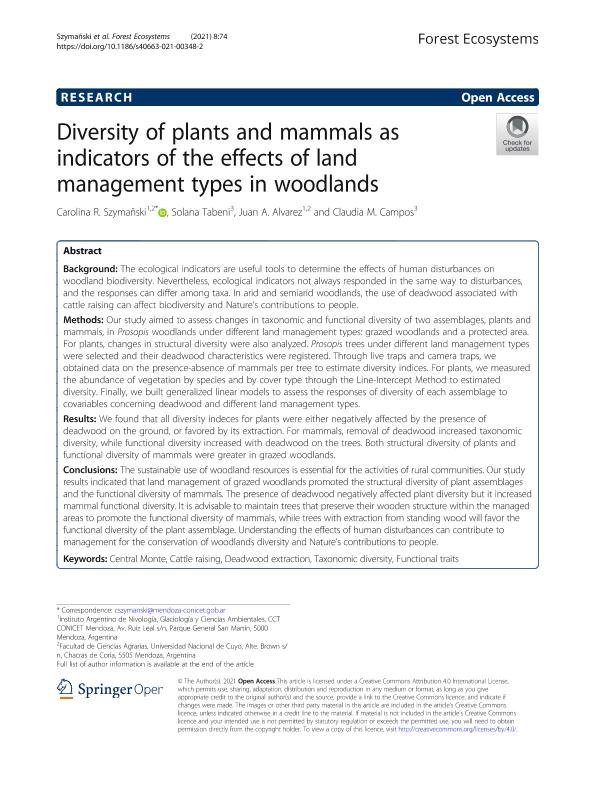Mostrar el registro sencillo del ítem
dc.contributor.author
Szymañski, Carolina

dc.contributor.author
Tabeni, Maria Solana

dc.contributor.author
Alvarez, Juan Agustin

dc.contributor.author
Campos, Claudia Monica

dc.date.available
2022-09-12T17:45:02Z
dc.date.issued
2021-12
dc.identifier.citation
Szymañski, Carolina; Tabeni, Maria Solana; Alvarez, Juan Agustin; Campos, Claudia Monica; Diversity of plants and mammals as indicators of the effects of land management types in woodlands; Springer; Forest Ecosystems; 8; 12-2021; 1-15
dc.identifier.issn
2095-6355
dc.identifier.uri
http://hdl.handle.net/11336/168395
dc.description.abstract
Background: The ecological indicators are useful tools to determine the effects of human disturbances on woodland biodiversity. Nevertheless, ecological indicators not always responded in the same way to disturbances, and the responses can differ among taxa. In arid and semiarid woodlands, the use of deadwood associated with cattle raising can affect biodiversity and Nature’s contributions to people. Methods: Our study aimed to assess changes in taxonomic and functional diversity of two assemblages, plants and mammals, in Prosopis woodlands under different land management types: grazed woodlands and a protected area. For plants, changes in structural diversity were also analyzed. Prosopis trees under different land management types were selected and their deadwood characteristics were registered. Through live traps and camera traps, we obtained data on the presence-absence of mammals per tree to estimate diversity indices. For plants, we measured the abundance of vegetation by species and by cover type through the Line-Intercept Method to estimated diversity. Finally, we built generalized linear models to assess the responses of diversity of each assemblage to covariables concerning deadwood and different land management types. Results: We found that all diversity indeces for plants were either negatively affected by the presence of deadwood on the ground, or favored by its extraction. For mammals, removal of deadwood increased taxonomic diversity, while functional diversity increased with deadwood on the trees. Both structural diversity of plants and functional diversity of mammals were greater in grazed woodlands. Conclusions: The sustainable use of woodland resources is essential for the activities of rural communities. Our study results indicated that land management of grazed woodlands promoted the structural diversity of plant assemblages and the functional diversity of mammals. The presence of deadwood negatively affected plant diversity but it increased mammal functional diversity. It is advisable to maintain trees that preserve their wooden structure within the managed areas to promote the functional diversity of mammals, while trees with extraction from standing wood will favor the functional diversity of the plant assemblage. Understanding the effects of human disturbances can contribute to management for the conservation of woodlands diversity and Nature’s contributions to people.
dc.format
application/pdf
dc.language.iso
eng
dc.publisher
Springer

dc.rights
info:eu-repo/semantics/openAccess
dc.rights.uri
https://creativecommons.org/licenses/by/2.5/ar/
dc.subject
CATTLE RAISING
dc.subject
CENTRAL MONTE
dc.subject
DEADWOOD EXTRACTION
dc.subject
FUNCTIONAL TRAITS
dc.subject
TAXONOMIC DIVERSITY
dc.subject.classification
Ecología

dc.subject.classification
Ciencias Biológicas

dc.subject.classification
CIENCIAS NATURALES Y EXACTAS

dc.title
Diversity of plants and mammals as indicators of the effects of land management types in woodlands
dc.type
info:eu-repo/semantics/article
dc.type
info:ar-repo/semantics/artículo
dc.type
info:eu-repo/semantics/publishedVersion
dc.date.updated
2022-09-01T15:25:27Z
dc.identifier.eissn
2197-5620
dc.journal.volume
8
dc.journal.pagination
1-15
dc.journal.pais
Alemania

dc.description.fil
Fil: Szymañski, Carolina. Consejo Nacional de Investigaciones Científicas y Técnicas. Centro Científico Tecnológico Conicet - Mendoza. Instituto Argentino de Investigaciones de las Zonas Áridas. Provincia de Mendoza. Instituto Argentino de Investigaciones de las Zonas Áridas. Universidad Nacional de Cuyo. Instituto Argentino de Investigaciones de las Zonas Áridas; Argentina. Universidad Nacional de Cuyo. Facultad de Ciencias Agrarias; Argentina
dc.description.fil
Fil: Tabeni, Maria Solana. Consejo Nacional de Investigaciones Científicas y Técnicas. Centro Científico Tecnológico Conicet - Mendoza. Instituto Argentino de Investigaciones de las Zonas Áridas. Provincia de Mendoza. Instituto Argentino de Investigaciones de las Zonas Áridas. Universidad Nacional de Cuyo. Instituto Argentino de Investigaciones de las Zonas Áridas; Argentina
dc.description.fil
Fil: Alvarez, Juan Agustin. Universidad Nacional de Cuyo. Facultad de Ciencias Agrarias; Argentina. Consejo Nacional de Investigaciones Científicas y Técnicas. Centro Científico Tecnológico Conicet - Mendoza. Instituto Argentino de Investigaciones de las Zonas Áridas. Provincia de Mendoza. Instituto Argentino de Investigaciones de las Zonas Áridas. Universidad Nacional de Cuyo. Instituto Argentino de Investigaciones de las Zonas Áridas; Argentina
dc.description.fil
Fil: Campos, Claudia Monica. Consejo Nacional de Investigaciones Científicas y Técnicas. Centro Científico Tecnológico Conicet - Mendoza. Instituto Argentino de Investigaciones de las Zonas Áridas. Provincia de Mendoza. Instituto Argentino de Investigaciones de las Zonas Áridas. Universidad Nacional de Cuyo. Instituto Argentino de Investigaciones de las Zonas Áridas; Argentina
dc.journal.title
Forest Ecosystems
dc.relation.alternativeid
info:eu-repo/semantics/altIdentifier/doi/http://dx.doi.org/10.1186/s40663-021-00348-2
Archivos asociados
